Golf is the most satisfying, yet challenging game you'll ever play. We here at Pin High Pro have played for many years and have always enjoyed the camaraderie, competition and shot knowledge required on each and every strike.
Like other golfers, we read golf magazines, watch golf tournaments on TV and listen to friends when they explain why we had an errant strike.
All of this incoming information is good because it's golf related, but it can certainly get you out of sync. We hear open your stance, close your stance, left shoulder is not high enough, etc... Every now and then it's time to reset.
We need to re-establish the golf swing basics.
Let's start from square one and review what matters in a great golf swing. The most important segments for a smooth, powerful golf swing are:
- Grip
- Setup/Posture
- Alignment
- Backswing
- Downswing (Weight Shift)
- Follow Through
Now we can break all these segments down so we can rebuild your swing (or at least fine tune it).
Grip
A good grip that can be repeated every time you grab a club is the beginning of re-establishing basics. This is the segment that almost all golf instructors start with as almost all amateur golfers hold the golf club improperly.
Since we're going back to basics, let's remember what the grip is for in your golf swing. It's just a way to connect your body to the club.
The grip isn't to generate power, it's to act as the transmission of the power and energy your whole body generates as you go through your swing. The grip you use with your clubs is critical because, without a good and reliable transmission, you won't get very far on the road to a better golf game.
Without a good and reliable transmission, you won't get very far on the road to a better golf game.
Your grip should be tight enough to keep the club in place, but loose enough to hinge when the body turns toward the ball strike. The club should lay across the second joint of your index finger with the butt end of the grip sitting just below the meaty pad at the base of your palm.
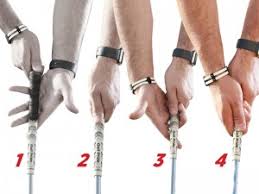
If it helps you to visualize, when you grip the club first with your left hand, that hand should roughly form an inverted letter "V." Make sure that inverted "V" is pointed at the opposite shoulder (your right) when you begin to close the grip. The same is true for when you grip with your right hand. Make an inverted "V" that is pointed to the opposite shoulder (left) when you close the grip.
Basic Setup for Golf Swing
A consistent routine when setting up to the ball is paramount. If you notice the professionals, every time they address the ball, their individual set up routine is the same.
There are so many segments in the golf swing that placing some of the basic moves on auto pilot keeps the swing thoughts down. Likewise, you should repeat the same set up every time you address the ball.
Good golf swing stance weight distribution is 55% on the rear foot and 45% on the front.
One of the easiest and most effective setup procedures is to align your body with the position of the clubface, then set your feet at shoulder width. As you bend forward, bend at the hips, keeping the back vertebra straight.
Have slightly more body weight on your rear foot (the one furthest from the hole). Weight distribution is approximately 55% on the rear foot and 45% on the front.
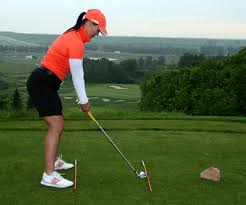
This setup places you, the golfer, in position to coil during the backswing and start the downswing with the lower body transferring weight to the front foot prior to striking the ball.
Golf Stance Alignment
Your body should be facing straight ahead, with the target at a 90-degree angle. To help with alignment, set a club or alignment stick on the ground that's pointed straight at the target. This takes the guesswork out of if you're in the correct position to hit the target.
Be able to focus on the rhythm of your golf swing, not how you're standing.
Point your toes out, approximately 30 degrees, to provide a little more freedom during the backswing and follow through.
Having a setup routine that you follow as you address the ball each time will establish the habit needed to “know” you haven’t forgotten anything so the focus can be on the rhythm of your swing, not how you're standing.
Backswing
Keep your arms in a fixed triangle position turn until your left shoulder is under your chin. At this point, your back should be pointing toward the target and you should notice the stretch in the back muscles.
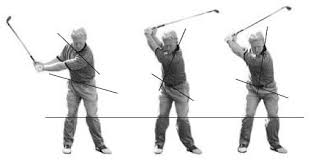
Since you're "loading" your back leg during the backswing pivot, the thigh muscles will also be stretched, storing the energy needed to start the downswing and strike the ball. Imagine a twisted rubber band. Ready to release all that potential energy.
Downswing (Shift Your Weight)
As the body rotates and muscles tighten at the end of the backswing, it's time to almost immediately begin the weight forward movement. The transition from the back swing to the downswing is initiated by the lower body, specifically the legs.
As weight is transferred to the forward side, the upper body, arms, hands, and club are lagging behind. This is where the subtle art of "lag" comes into play.
Creating lag in your golf swing is maintaining the angle between your leading forearm (left arm if you're a right-handed golfer) and the shaft of the golf club. More power is generated from lag if you can maintain this angle for as long as you possibly can.
Lag is what separates a powerful swing from an OK swing.
As the body rotates the last of the weight forward, the centripetal force is generating the speed and power needed to strike the ball.
Many golfers utilize what's known as "body compression." This is a segment of a proper downswing where the rear shoulder slightly dips compressing the legs which spring just prior to the ball-strike, intensifying the clubhead speed just prior to the strike.
Numerous golf authors use the example of the figure-skater twirling in one spot. The skater is spinning at a constant speed with arms extended, however, when the arms are pulled in closer to the body the rate of spin increases significantly.
Think "figure-skater" when you hear "body compression."
This principle of physics also works during the downswing in golf because the body is compressed storing more energy that is released just prior to striking the ball.
Another visualization of what the body should be doing during the downswing is defined by David Leadbetter in his book, The Golf Swing.
To paraphrase David, you should visualize a figure-eight when going through your downswing. Your right hip shifts behind you as you wind back, only to gently shift diagonally to the right of your target. You complete the figure-eight with your left hip as you clear the follow-through.
The illustration he uses has this figure eight movement taking place inside a barrel, reminding the golfer not to sway or slide during the downswing but to turn, which generates the maximum amount of torque needed for a pure ball strike.
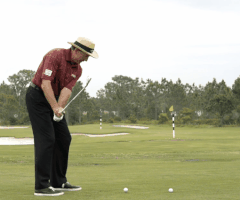
Swing Follow Through
The golf swing follow through is basic and crucial if you want to convert your swing torque into a powerful ball strike.
Many golfers do not complete the follow through segment of the swing. Many don't even realize they stopped the swing before completion, while others believe it's all over after the club strikes the ball.
Both are missing out on the power of the strike and ball control. If you think of the body weight that is being transferred from the rear to the front foot, slowing down that transfer will kill power.
When the complete transfer takes place, not only is the club head hitting the ball, but the clubface will be square at impact assuring a straight ball path. When the weight is properly shifted to the front foot, the golfer's belt buckle should be pointing at the target. Weight should also be "posted" on the front foot with the rear foot resting on the toe.
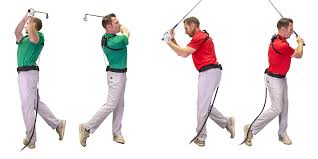
In the above photo, the golfer in the red shirt stopped his swing which would have killed control and distance, while the golfer in the green shirt had his weight posted to the front foot with the rear foot resting to the toe.
When weight is posted on the front foot, all of the energy coiled and stored in the body core is released through centripetal force. The only way to strike the ball first and take a divot is to have weight on the front foot prior to the strike.
Hitting the ball first gives you distance and control on all golf shots. The divot created by the ball strike is confirmation that the weight was forward and the ball was hit first.
The divot created by the ball strike is confirmation that the weight was forward and the ball was hit first.
Many golfers have difficulty shifting weight to the front foot prior the striking the ball. Other golfers don't even realize their weight was not planted on the front foot prior to the strike.
Solution to Weight Shift Problem
While there are a handful of golf swing aids available, we're understandably partial to the American-made Pocket Pin High Pro, of course. As an ultra-portable swing aid that slides under the outside edge of the golfer's front foot, this swing aid is a simple and easy way to improve all of your swings.
If you don't already know, you will hear the Pocket Pin High Pro "CLICK!" when weight is transferred forward during your downswing. If you don't hear a "CLICK," then you know you didn't shift your weight properly.
The Pocket Pin High Pro helps you with a more powerful swing by teaching you to properly shift weight during your downswing.
Regular practice with the Pocket Pin High Pro will establish the muscle memory to shifting weight forward. You will shift weight forward more consistently with fewer swing thoughts! The "sensation" of weight shifting forward, confirmed by the Pocket Pin High Pro's "CLICK" gives you the swing sequence needed to be replicated for better ball strikes.
We hope this in-depth golf swing article helps you with your game (we know the Pocket Pin High Pro goes a long way there too!).

Leave a comment: